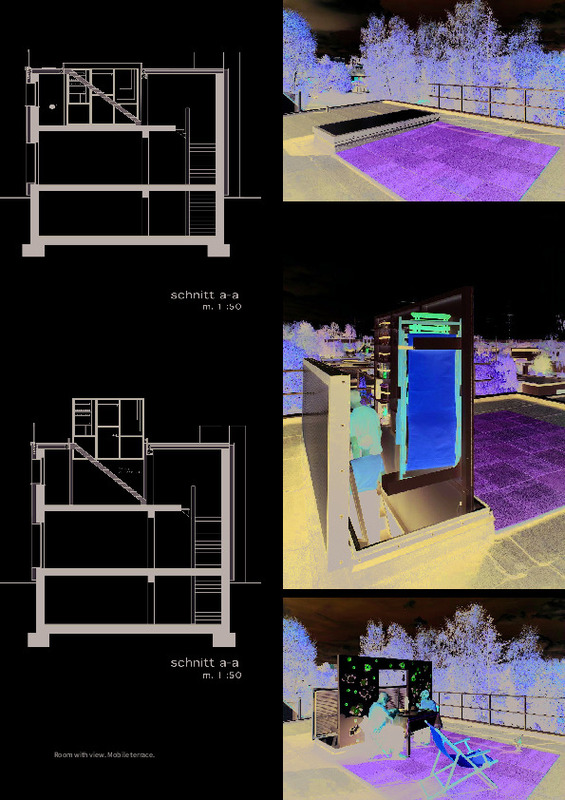JavaScript is disabled for your browser. Some features of this site may not work without it.
Buscar en RiuNet
Listar
Mi cuenta
Estadísticas
Ayuda RiuNet
Admin. UPV
Environmental and technological flexibility for new housing needs
Mostrar el registro sencillo del ítem
Ficheros en el ítem
| dc.contributor.author | Radogna, Donatella
|
es_ES |
| dc.contributor.author | Kalhofer, Gerhard
|
es_ES |
| dc.date.accessioned | 2022-07-12T07:40:05Z | |
| dc.date.available | 2022-07-12T07:40:05Z | |
| dc.date.issued | 2022-06-29 | |
| dc.identifier.uri | http://hdl.handle.net/10251/184005 | |
| dc.description.abstract | [EN] Over time, the economic and social conditions determined expansion and contraction processes of the domestic space (from the cave to the castle, from the castle to the studio flat) with important consequences on people s life quality. This evolution stimulated the development of cultural debates and design experiments on the theme of flexibility. In the contemporary scenario, flexibility has a big value because it represents an important design strategy to meet the needs of contemporary living in a sustainable dimension. For more than twenty years, the authors have been linked by a working relationship aimed at comparing theoretical scientific developments and design practice. This paper offers some reflections on the evolution of flexibility concept in residential construction by providing concrete examples through the reading of some projects. The variations of flexibility are debated with reference to the people s needs in the adaptive reuse of buildings. The writing faces the functional mix and the modifiability of interior spaces given by the design of flexible technological units (partitions, systems, furnishings) and mobile additions as well as the adaptability of the closures with respect to climatic and seasonal conditions. The theme of flexibility, too often oversized and not investigated in terms of feasibility, is presented in a possible and useful scale. Flexibility is also faced as a new way for showing the link between utility and beauty of the spaces. | es_ES |
| dc.language | Inglés | es_ES |
| dc.publisher | Universitat Politècnica de València | es_ES |
| dc.relation.ispartof | VITRUVIO - International Journal of Architectural Technology and Sustainability | es_ES |
| dc.rights | Reconocimiento - No comercial (by-nc) | es_ES |
| dc.subject | Housing | es_ES |
| dc.subject | Changing needs | es_ES |
| dc.subject | Transformable architecture | es_ES |
| dc.title | Environmental and technological flexibility for new housing needs | es_ES |
| dc.type | Artículo | es_ES |
| dc.identifier.doi | 10.4995/vitruvioijats.2022.17461 | |
| dc.rights.accessRights | Abierto | es_ES |
| dc.description.bibliographicCitation | Radogna, D.; Kalhofer, G. (2022). Environmental and technological flexibility for new housing needs. VITRUVIO - International Journal of Architectural Technology and Sustainability. 7(1):30-45. https://doi.org/10.4995/vitruvioijats.2022.17461 | es_ES |
| dc.description.accrualMethod | OJS | es_ES |
| dc.relation.publisherversion | https://doi.org/10.4995/vitruvioijats.2022.17461 | es_ES |
| dc.description.upvformatpinicio | 30 | es_ES |
| dc.description.upvformatpfin | 45 | es_ES |
| dc.type.version | info:eu-repo/semantics/publishedVersion | es_ES |
| dc.description.volume | 7 | es_ES |
| dc.description.issue | 1 | es_ES |
| dc.identifier.eissn | 2444-9091 | |
| dc.relation.pasarela | OJS\17461 | es_ES |
| dc.description.references | Arbizzani, E., Baratta, A., Cangelli, E., Daglio, L., Ottone, F., Radogna, D. (2021), Architettura e Tecnologia per l’abitare. Upcycling degli edifici ERP di Tor Bella Monaca a Roma, Studi e progetti Serie, Maggioli, Santarcangelo di Romagna (Rn). | es_ES |
| dc.description.references | Calcagnini L. (2018) Flessibilità. Una dimensione strategica per l’architettura, Cultura tecnologica e linguaggio architettonico Serie, Edizioni ETS, Pisa. | es_ES |
| dc.description.references | Radogna, D. (2008) Kalhöfer & Korschildgen. Flessibilità ed esigenze d’uso. Soluzioni progettuali per un quadro prestazionale variabile, Sala Editori, Pescara. | es_ES |
| dc.description.references | Radogna, D. (2012) La flessibilità per un Social Housing sostenibile: il caso di Preturo (AQ).TECHNE, Journal of Technology for Architecture and Environment, vol. 4, Social Housing. | es_ES |
| dc.description.references | Radogna D. (2013) Flessibilita’ spaziale e tecnologica. In: Di Giulio R., Boeri A., Forlani M. C., Gaiani A., Manfron V., Pagani R. (ed.), Paesaggi periferici. Strategie di rigenerazione urbana, Quodlibet, Macerata | es_ES |
| dc.description.references | Radogna D. (2020) Sistemi costruiti in via di sviluppo. In: Arbizzani E., Cangelli E., Daglio, L., Ginelli, E., Ottone, F., Radogna D. (ed.) Progettare in vivo la rigenerazione urbana, Studi e progetti Serie, pp. 39-42, Maggioli, Santarcangelo di Romagna (Rn). | es_ES |








